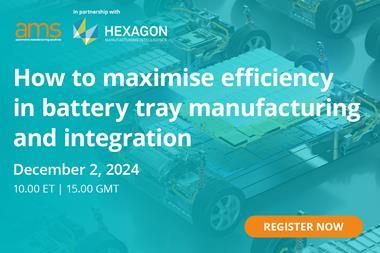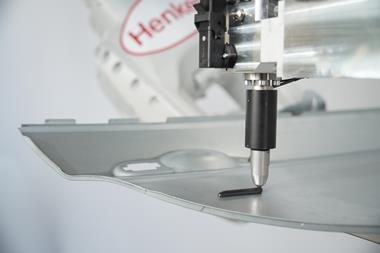New materials are creating additional challenges in vehicle assembly. AMS reports on the joining solutions being adopted by OEMs
Launched at the New York Auto Show in March 2013, the second-generation Range Rover Sport neatly illustrates the major trends in fastening and joining in automotive final assembly, according to Adrian Ellis, UK sales manager for German fastener manufacturer Profil Verbindungstechnik. Specifically, the car contains almost 350 rivet nuts and studs, ranging from M6 to M14 in size, each of which would have been a welded fastener in previous models.

“The big trend is still lightweighting, which means introducing new, lighter and thinner materials – aluminium (as in the case of the all-aluminium Range Rover Sport), high-strength steels, and carbon fibre – which then leads to the challenge of joining them together and attaching other vehicle parts to them,” says Ellis.
Martin Kinsella, Detroit-based director of advanced materials at Italian industrial robotics and body welding specialist Comau, concurs. “Driven by the need to reduce their vehicles’ carbon emissions and fuel efficiency, automotive OEMs are reducing vehicle weights by using advanced materials such as high-strength steel, aluminium and even magnesium alloys,” he says. “Compared to traditional materials, there are a number of significant challenges, and during 2013 we’ve been investing equally significantly to meet them.”
As well as meeting the technical challenges, those investments have been aimed at increasing the pace of innovation. Comau has developed a number of international centres of excellence, Kinsella explains, each equipped with its own testing facilities to avoid sending test pieces to thirdparty technology testing laboratories.
There is also an emphasis on speeding up the time taken to join these lightweight materials together so they can be applied in fast-moving high-volume automotive assembly environments. “The challenge is to cut the cycle times and to achieve sub-60-second and sub-50-second cycle times,” says Kinsella. “Which in turn is impacted by the number of variables affecting the process; material coatings, material thickness, material stack-up, and how the joints are actually formed – all these factors impact on the process.”
Profil’s Ellis agrees, pointing to a drive by some of Europe’s most advanced OEMs to automate fastener insertion through the use of C-frames, constructed of cast iron or flame-cut steel, acting as an anvil, and utilising a hydraulic oil cylinder with an attached pierce head or nutting head as the ‘hammer’, firing the fastener into the panel as the vehicle passes down the line, directly onto the body assembly.
“It’s something that we’ve seen in Europe at BMW and Audi, which has now been taken up by Jaguar Land Rover,” he notes. “It’s very different from traditional approaches, because there’s zero impact on the cycle time; it’s done within the cycle. At the moment it’s a rarity, but we expect the rest of the market to follow.” Increasingly, he adds, automotive OEMs are demanding higher-technology, stronger, lighter fasteners that can be utilised over a range of materials and material thicknesses.
This year, for instance, Profil’s flagship range of RND flanged rivet nuts has been extended by the addition of a new derivative, designated RND Light. Driven by the market’s demands for low weight with increased performance and reduced costs, and available in M6, M8, M10, and M12 sizes, RND Light is already being adopted by several of Europe’s premium automotive OEMs, says Ellis.
Compared to standard weld-based joining procedures, the mechanical attachment of a rivet nut offers a cost saving of up to 50% and is suitable for many different kinds of metals, including surface-coated metals and sandwich metals, stretching from aluminium to high-strength steels in the 1000-1500 megapascal tensile strength range.
RND Light extends these advantages, offering a better performance in thin and sandwich material than the RND standard rivet nut, at weight savings of up to 50% compared to the standard RND rivet nut, as well as cost savings too. What’s more, says Ellis, the new range offers an expanded range of thickness – with a single fastener capable of covering between 0.5mm and 3mm – allowing it to replace pierce nuts as standard components.
“Customers are realising that one part number can cover 90% of the vehicle, which is why we increasingly talk of an ‘in place’ cost, or total cost of acquisition,” says Ellis. “There’s one part number to order, one part number to stock and transport, and one part number to manage. The result is a considerable gain in simplification.”
Over at Japanese robotic automation supplier Fanuc, the same broad trends are being seen – with some interesting consequences from an automation perspective, says Neil Dueweke, head of Fanuc’s body structures segment. “The requirement for lighter and more efficient vehicles has really broken the mould of the MIG welding, spot welding and resistance welding tradition, and manufacturers are actively looking at alternative approaches – flow-drilling, riveting and even clinching and roller hemming,” he says.
Re-adopting joining techniques
Pointing to upcoming models such as Ford’s 2015 model year F-150 pickup truck – a reported 300kg lighter than its predecessor, thanks to extensive use of aluminium and plastics – Dueweke sees the industry re-adopting old joining techniques, as well as applying techniques found in other industries but not previously in automotive.
“Look at the vehicles such as the F-150 and you can see automotive OEMs saying to themselves: ‘We’ve got to join steel to aluminium – how are we going to do that?’,” says Dueweke. “And the answer is techniques such as clinching, hemming, and flow-drilling.”
In the case of flow-drilling – where the robot exerts a point force on a particular location to deform the metal and create a ‘funnel’ into which fasteners can be screwed – that calls for bigger robots in order to exert the forces required. Clinching and hemming, though, call for smaller, more nimble robots, capable of a greater throughput at a higher speed. And often, they’re side by side.
Comau’s Kinsella agrees, pointing out that the resurgence of clinching and hemming has seen the company introduce a new roller hemming head in the past few months which is capable of higher speeds.
“There are certain processes where clinching and hemming are still good solutions,” he notes. “The result isn’t as strong or durable as with some alternative solutions, but on the other hand, there are some advantages – there’s no need for a consumable such as a screw, and from a strength point of view, it can be fit for purpose.”
Adhesives, too, are increasingly finding favour. “Using adhesives for body manufacture – adhesives which can be formulated for aluminium, steel and composite bonding applications on unprepared surfaces – is a trend that’s on the rise with auto-makers,” sums up Jeff Kapp, a structural adhesives specialist within 3M’s automotive division. “Some manufacturers have been reporting up to a 50% increase in use.”
Cost and lightweighting are driving the trend, of course, but so too is a recognition that adhesives, by offering a continuous bond along joined surfaces – as opposed to one pinned at various points by fasteners – actually deliver improved strength and crash resistance.
 Adhesives that grip metal can be used in their own right for their other properties, combining two solutions in one. Henkel’s fourth-generation Teroson RB 8275, launched this year, is an adhesive in the form of a liquid-applied sound deadener (LASD), sprayed into floor wells by robots as vehicles move along the assembly line. Lighter than the bitumen mats it replaces by 20%, the result is a weight saving of roughly a kilogram per vehicle.
Adhesives that grip metal can be used in their own right for their other properties, combining two solutions in one. Henkel’s fourth-generation Teroson RB 8275, launched this year, is an adhesive in the form of a liquid-applied sound deadener (LASD), sprayed into floor wells by robots as vehicles move along the assembly line. Lighter than the bitumen mats it replaces by 20%, the result is a weight saving of roughly a kilogram per vehicle.
“That may not seem much to a non-specialist, but it represents a huge step forward for a vehicle designer habitually endeavouring to save a gram here or there,” explains Manfred Kosche, Henkel product line manager for LASD products.
In addition, adhesives are helping the drive to eliminate weight by permitting the use of thinner steels by providing reinforcement, says Marc Ullmann, sealing and gluing technology application specialist at German automotive adhesives specialist Dürr Systems.
“In roof reinforcement dampening, the steel roof sheet is reinforced with a coated cardboard, with both layers being connected with an adhesive,” he says. “This procedure is used in order to reduce noise, vibration and weight by enabling the use of thinner steel roof sheets, and requires the simultaneous application of up to 13 parallel adhesive beads.”
Likewise, he adds, in another application that goes beyond the classic use of adhesives in window panel gluing, adhesives are finding favour in the insertion of plastic, aluminium or carbon-reinforced CFK roofs, which are painted and inserted into the roof cut out at the same station as the roof modules. Once again, the motivation is lightweighting, as the roofs are lighter than the steel they replace.
While traditional welding techniques aren’t dead yet, innovative alternatives are providing serious competition.


































